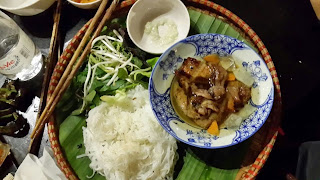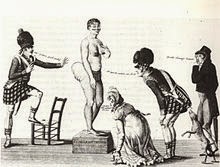Such an amazing city, especially in comparison to Jakarta, my residence. The total population of Greater Hanoi, that
is the administrative region, was 7.1m in 2014, or 2.9m for the urban part and
the remainder spread out over "rural" Hanoi. Nearly three million
people, a great many cars and even more motorcycles and scooters in the city
proper, and yet no traffic jams. And development appears to take place at an
astonishing speed—the new Noi Bai airport and a new six-lane highway connecting it to Hanoi; new roads inside the town and flyovers being constructed; new
high-rise offices, shopping centres, hotels, apartments. Exactly four years ago
I was here on a project-assignment, the hotel I stayed (in the old town) was at
six floors the largest building in the narrow street, now it is dwarfed by a fancy
recent addition to the Hanoi hotel-world. And in contrast to Jakarta, the
developmental activities appear to work as intended and are completed on time—the
new highway, for example, is of superb quality and includes a magnificent
bridge across the Red River.
Located on the right bank of the Red River,
Hanoi marked its one-thousand years as a city in October 2010. It had been
inhabited long before, since somewhere around 3000 BC in fact, but it was
Emperor Ly Thai To who in 1010 moved his capital there. He
renamed it Thang Long (Soaring Dragon) as he claimed to
have seen a dragon rising from the Red River. In 1802 the capital was moved to
Hué by Emperor Gia Long, founder of the Nguyen dynasty. In 1831 Thang
Long was
named Hanoi, and from 1902 to 1953 it served as the capital of French Indochina.
And finally, after 30 years of war, Hanoi became the capital of the Socialist Republic
of Vietnam in 1976.
Sights worth a visit.
The nearly four
kilometres long Ceramic Road, based
on the idea of journalist Nguyen Thu Thuy to transform
the dyke system around Hanoi into a ceramic mosaic in
celebration of 1000-years-Hanoi, was officially entered into the Guinness Book
of World Records on 5 October 2010 as the largest mosaic in the world. It could
even be called an international cooperative effort as foreign contributions can
also be identified—see for instance the Spanish mosaic with its bottle of Rioja
2010 and the text Vamos a la Playa;
and a bit further down Dutch windmills and tulips can also be identified. Definitely
worth a visit.
In my previous
blog I already mentioned that a stroll through the Old Town is highly enjoyable. Its 36 streets, some wide and others
very narrow, are full of life. In the past these streets were arranged by
trade—textiles, silverwork, shoes and sandals, and the like. Nowadays less so,
but the exiting and intoxicating atmosphere and beautifully organised chaos is
still strikingly evident.
The Ho
Chi Minh Museum, as the name implies, is dedicated to a single person: Ho
Chi Minh. Born Nguyen That Thanh, he adopted the name Ho Chi Minh, meaning the Bringer
of Light, when he founded the Viet Minh, a
communist-dominated independence movement, to fight the Japanese. Ho Chi Minh
was the leader of the Vietnamese nationalist movement and the President of North
Vietnam from 1954 till his death in 1969.
The museum is dedicated to his many contributions in the fields of culture, education and the arts, and his devotion
to the national liberation of the Vietnamese people, and contributing to the
common struggle of peoples for peace, national independence, democracy and
social progress.[1]
A bewildering assemblage of objects and
images is shown. What to make, for instance, of these photos
(shown below) reproduced on glass and accessible from both sides.
The interpretation of the ones below seems clear:
…common struggle of peoples for peace,
national independence, democracy and social progress.
Definitely worth a visit, and if the Ho Chi Minh Mausoleum is open, I do
recommend you join the silent queue of people filing past his tomb.
 |
| Main entrance |

Serene tranquility inside the compound
 |
| Hoa Lo Prison main gate |
For those of us who remember Jane Fonda as
an anti-war protester, a visit to the Hoa
Lo Prison, or the Hanoi Hilton as it was called by the American prisoners of war, a visit would be interesting.


















